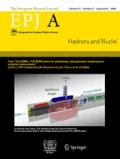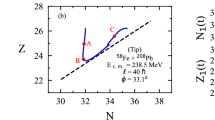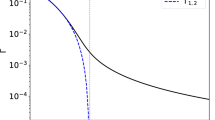Abstract
The \(\alpha \) decay half-lives and the fine structure phenomenon are investigated with fission-like models. A superasymmetric fission path in a configuration space spanned by five degrees of freedom is determined in accordance with the least action principle. The deformation energy is evaluated within the macroscopic–microscopic approach while the inertia is obtained in the framework of the cranking model. The single particle levels schemes are calculated connecting the ground state of the parent nucleus and the asymptotic configuration of two separated nuclei. The probabilities to find different seniority configurations are obtained by solving time-dependent pairing equations generalized by including the Landau–Zener effect and the Coriolis coupling. The microscopic equations of motion for even numbers of particles are deduced, those for odd-nuclear systems being obtained in previous works. The models used in the calculations are reviewed within a detailed description. The microscopic equations of motion are solved by starting from the ground state configuration and arriving at the scission point. A description of all the possible configurations at scission together with their realization probabilities is given. By fitting the inter-nuclear velocity, the best agreement between experimental and theoretical hindrance factors is retained. The theoretical results for the \(\alpha \) decay half-lives for \(^{211,212}\)Po and \(^{211}\)Bi are compared with experimental data showing discrepancies ranging over three orders of magnitude. The accuracy of the model concerning the calculations of the half-lives for different channels is discussed. The connections between the classical theories concerning the preformation of the \(\alpha \) particle and the fission-like descriptions are highlighted.















Similar content being viewed by others
Data Availability Statement
This manuscript has no associated data or the data will not be deposited. [Authors’ comment: The article provides an interpretation of the alpha decay fine structure in terms of fission-like models.]
References
H.J. Mang, Zur theorie des \(\alpha \)-zerfalls. Z. Phys. A 148, 582–592 (1957)
H.J. Mang, Alpha decay. Annu. Rev. Nucl. Sci. 14, 1–26 (1964)
A. Sandulescu, O. Dumitrescu, Alpha decay to vibrational states. Phys. Lett. 19, 404–407 (1965)
S. Rosenblum, Structure fine du spectre magnetique des rayons \(\alpha \) du thorium C. C.R. Acad. Sci. Paris 188, 1401–1403 (1929)
A. Bohr, P.O. Froman, B.R. Mottelson, On the fine structure in alpha decay. Dan. Mat. Fys. Medd. 29, 10 (1955)
R.G. Thomas, A formulation of the theory of alpha-particle decay from time-independent equations. Prog. Theor. Phys. 12, 253–264 (1954)
D.F. Jackson, M. Rhoades-Brown, Theories of alpha-decay. Ann. Phys. 105, 151–186 (1977)
D.S. Delion, Theory of Particle and Cluster Emission. Lecture Notes in Physics 819 (Springer, Berlin, 2010)
D.S. Delion, A. Dumitrescu, Systematics of the \(\alpha \)-decay fine structure in even-even nuclei. At. Data Nucl. Data Tabl. 101, 1–40 (2015)
D.S. Delion, Z. Ren, A. Dumitrescu, D. Ni, Coupled channels description of the \(\alpha \)-decay fine structure. J. Phys. G: Nucl. Part. Phys. 45, 053001 (2018)
G. Bencze, A. Sandulescu, Barrier penetrabilities and the alpha-nucleus potential. Phys. Lett. 22, 473–474 (1966)
K. Wildermuth, T. Kanellopoulos, The “cluster model” of the atomic nuclei. Nucl. Phys. 7, 150–162 (1958)
D.M. Dennison, Energy levels of the \(^{16}\)O nucleus. Phys. Rev. 96, 378–380 (1954)
G. Röpke, A. Schnell, P. Schuck, P. Nozieres, Four-particle condensate in strongly coupled fermion systems. Phys. Rev. Lett. 80, 3177–3180 (1998)
A. Tohsaki, H. Horiuchi, G. Schuck, P. Röpke, Alpha cluster condensation in \(^{12}\)C and \(^{16}\)O. Phys. Rev. Lett. 87, 192501 (2001)
G. Röpke, P. Schuck, C. Xu, Z. Ren, M. Lyu, B. Zhou, Y. Funaki, H. Horiuchi, A. Tohsaki, T. Yamada, Alpha-like clustering in \(^{20}\)Ne from a quartetting wave function approach. J. Low Temp. Phys. 189, 383–409 (2017)
G. Röpke, P. Schuck, Y. Funaki, H. Horiuchi, Z. Ren, A. Tohsaki, C. Xu, T. Yamada, B. Zhou, Nuclear clusters bound to doubly magic nuclei: the case of \(^{212}\)Po. Phys. Rev. C 90, 034304 (2014)
C. Xu, Z. Ren, G. Röpke, P. Schuck, Y. Funaki, H. Horiuchi, A. Tohsaki, T. Yamada, B. Zhou, \(\alpha \)-decay width of \(^{212}\)Po from a quarteting wave function approach. Phys. Rev. C 93, 011306(R) (2016)
C. Xu, G. Röpke, P. Schuck, Z. Ren, Y. Funaki, H. Horiuchi, A. Tohsaki, T. Yamada, B. Zhou, \(\alpha \)-cluster formation and decay in the quarteting wave function approach. Phys. Rev. C 95, 061306(R) (2017)
V.V. Baran, D.S. Delion, Analytical approach for the quartet condensation model. Phys. Rev. C 99, 031303(R) (2019)
J. Dukelsky, G. Röpke, P. Schuck, Generalized Brückner–Hartree–Fock theory and self-consistent RPA. Nucl. Phys. A 628, 17–40 (1998)
M. Beyer, S.A. Sofianos, C. Kuhrts, G. Röpke, P. Schuck, The \(\alpha \)-particle in nuclear matter. Phys. Lett. B 488, 247–253 (2000)
O. Dumitrescu, New superconducting phase in nuclei. Sov. J. Part. Nucl. 23, 187–209 (1992)
M. Apostol, I. Bulboaca, F. Carstoiu, O. Dumitrescu, M. Horoi, Alpha-like four nucleon correlations in superfluid phases of atomic nuclei. Nucl. Phys. A 470, 64–78 (1987)
D.N. Poenaru, K. Depta, M. Ivascu, D. Mazilu, A. Sandulescu, W. Greiner, Calculated half-lives and kinetic energies for spontaneous emission of heavy ions from nuclei. At. Data Nucl. Data Tabl. 34, 423–538 (1986)
A. Sandulescu, W. Greiner, Cluster decays. Rep. Prog. Phys. 55, 1423–1481 (1992)
D.N. Poenaru, M. Ivascu, A. Sandulescu, Alpha decay as a fission-like process. J. Phys. G: Nucl. Phys. 5, L169–L173 (1979)
A. Zdeb, M. Warda, K. Pomorski, Half-lives for \(\alpha \) and cluster radioactivity within a Gamow-like model. Phys. Rev. C 87, 024308 (2013)
D.L. Hill, A.J. Wheeler, Nuclear constitution and the interpretation of fission phenomena. Phys. Rev. 89, 1102 (1953)
M. Mirea, Pairing gaps and Fermi energies at scission for \(^{296}\)Lv alpha-decay. Eur. Phys. J. A 51, 36 (2015)
M. Mirea, Fine structure of \(\alpha \) decay from the variational principle. Phys. Rev. C 96, 064607 (2017)
M. Mirea, Fine structure of \(^{211}\)Bi \(\alpha \)-decay from Coriolis coupling. EPL 124, 12001 (2018)
M. Mirea, Time-dependent pairing equations for seniority-one nuclear systems. Phys. Rev. C 78, 044618 (2008)
M. Brack, J. Damgaard, A.S. Jensen, H.C. Pauli, V.M. Strutinsky, C.Y. Wong, Funny Hills: the shell-correction approach to nuclear shell effects and its application to the fission process. Rev. Mod. Phys. 44, 320–405 (1972)
M. Warda, L.M. Robledo, Microscopic description of cluster radioactivity in actinide nuclei. Phys. Rev. C 84, 044608 (2011)
M. Warda, A. Zdeb, L.M. Robledo, Cluster radioactivity in superheavy nuclei. Phys. Rev. C 98, 041602(R) (2018)
N. Schunck, L.M. Robledo, Microscopic theory of nuclear fission: a review. Rep. Prog. Phys. 79, 116301 (2016)
J.R. Nix, Calculation of fission barriers for heavy and superheavy nuclei. Ann. Rev. Nucl. Sci. 22, 65–120 (1972)
A. Sandulescu, M. Mirea, D.S. Delion, Microscopic description of the alpha-decay of a superheavy element. EPL 101, 62001 (2013)
M. Mirea, A. Sandulescu, D.S. Delion, Predictions for \(^{232}\)U cluster-decays within the macroscopic-microscopic approximation. Nucl. Phys. A 870–871, 23–41 (2011)
M. Mirea, A. Sandulescu, D.S. Delion, \(^{238}\)Pu cluster decay in the macroscopic–microscopic approach. Eur. Phys. J. A 48, 86 (2012)
G.G. Adamian, N.V. Antonenko, H. Lenske, S.V. Tolokonnikov, E.E. Saperstein, Isotopic trends of nuclear surgace properties of spherical nuclei. Phys. Rev. C 94, 054309 (2016)
D.S. Delion, S. Peltonen, J. Suhonen, Systematics of the \(\alpha \)-decay to rotational states. Phys. Rev. C 73, 014315 (2006)
P. Moller, J.R. Nix, W.D. Myers, W.J. Swiatecki, Nuclear ground-state masses and deformations. Atom. Data. Nucl. Data. Tabl. 59, 185–381 (1995)
P. Moller, J.R. Nix, W.J. Swiatecki, Calculated fission properties of the heaviest elements. Nucl. Phys. A 469, 1–50 (1987)
P. Moller, J.R. Nix, Atomic masses and nuclear ground-state deformations calculated with a new macroscopic–microscopic model. Atom. Data. Nucl. Data. Tabl. 26, 165–196 (1981)
K.T.R. Davies, J.R. Nix, Calculation of moments, potentials, and energies for an arbitrarily shaped diffuse-surface nuclear density distribution. Phys. Rev. C 14, 1977–1994 (1976)
H.J. Krappe, J.R. Nix, W.D. Myers, A.J. Sierk, Unified nuclear potential for heavy-ion elastic scattering, fusion, fission, and ground-state masses and deformations. Phys. Rev. C 20, 992–1013 (1979)
V.M. Strutinsky, Shell effects in nuclear masses and deformation energies. Nucl. Phys. A 95, 420–442 (1967)
M. Mirea, Cranking inertia of odd nuclei from the time-dependent pairing equations: application to Th cold fission. Phys. Rev. C 100, 014607 (2019)
K. Pomorski, F. Ivanyuk, Pairing correlations and fission barrier heights. Int. J. Mod. Phys. E 18, 900–906 (2009)
M. Mirea, Pairing correction within the density-dependent delta interaction. Int. J. Mod. Phys. E 27, 1850076 (2018)
W.D. Myers, W.J. Swiatecki, Nuclear masses and deformations. Nucl. Phys. 81, 1–60 (1966)
B. Nerlo-Pomorska, K. Pomorski, On the average pairing energy in nuclei. Int. J. Mod. Phys. E 16, 328–336 (2007)
S. Cwiok, J. Dudek, W. Nazarewicz, J. Skalski, T. Werner, Single-particle energies, wave functions, quadrupole moments, and \(g\)-factors in an axially deformed Woods–Saxon potential with applications to the two-centre-type nuclear problems. Comput. Phys. Comun. 46, 379–399 (1987)
P. Holzer, U. Mosel, W. Greiner, Double-centre oscillator and its application to fission. Nucl. Phys. A 138, 241–252 (1969)
J. Maruhn, W. Greiner, The asymmetric two center shell model. Z. Phys. 251, 431–457 (1972)
E. Badralexe, A. Sandulescu, Potentialul de oscilator cu doua centre. St. Cerc. Fiz. 25, 1087–1114 (1973)
E. Badralexe, M. Rizea, A. Sandulescu, Symmetric two-center model wave functions. Rev. Roum. Phys. 19, 63–80 (1974)
M. Mirea, superasymmetric two-center shell model for spontaneous heavy-ionemission. Phys. Rev. C 54, 302–314 (1996)
M. Mirea, Energy partition in low energy fission. Phys. Rev. C 83, 054608 (2011)
M. Mirea, Microscopic description of energy partition in fission fragments. Phys. Lett. B 717, 252–256 (2012)
M. Mirea, Microscopic description of the odd-even effect in cold fission. Phys. Rev. C 89, 034623 (2014)
H.C. Pauli, On the shell model and its application to the deformation energy of heavy nuclei. Phys. Rep. 7, 35–100 (1973)
K.-H. Schmidt, J. Beatriz, Review on the progress in nuclear fission-experimental methods and theoretical descriptions. Rep. Prog. Phys. 81, 106301 (2018)
D.R. Inglis, Particle derivation of nuclear rotation properties associated with a surface wave. Phys. Rev. 96, 1059 (1959)
M. Mirea, Nuclear Inertia from the time dependent pairing equations. J. Phys. G Nucl. Part. Phys. 43, 105103 (2016)
W. Brodzinski, M. Kowal, J. Skalski, P. Jachimowicz, Fission of SHN and its hindrance: odd nuclei and isomers. Acta Phys. Pol. B 49, 621–630 (2018)
T. Ledergerber, H.-C. Pauli, On the dynamics on fission: the role of reflection symmetry in the nuclear shape. Nucl. Phys. A 207, 1–32 (1973)
O. Prior, F. Boehm, S.G. Nilsson, Collective gyromagnetic ratios of deformed nuclei. Nucl. Phys. A 110, 257–272 (1968)
R. Rodríguez-Guzmán, L.M. Robledo, Microscopic description of fission in nobelium isotopes with the gogny-d1m energy density functional. Eur. Phys. J. A 52, 348 (2016)
S. Bjornholm, J.E. Lynn, The double-humped fission barrier. Rev. Mod. Phys. 52, 725–931 (1980)
M. Mirea, Complex potentials in fission. Rom. J. Phys. 64, 305 (2019)
J.A. Wheeler, Nuclear fission and nuclear stability, Niels Bohr and the Development of Physics (London, Great Britain) (Pergamon Press Ltd, Oxford, 1955), pp. 163–184
A. Astier, P. Petkov, M.-G. Porquet, D.S. Delion, P. Schuck, Coexistence of \(\alpha +^{208}\)Pb cluster structures and single-particle excitations in \(^{212}_{84}\)Po\(_{128}\). Eur. Phys. J. A 46, 165–185 (2010)
D.M. Wang, G. Audi, F.G. Kondev, W.J. Huang, S. Naimi, X. Xu, The Ame 2016 atomic mass evaluation (II). Tables, graphs and references. Chin. Phys. C 41, 030003 (2017)
A. Ritz, Recommended energy and Intensity values of alpha particles from radioactive decay. Atom. Data Nucl. Data Tabl. 47, 205–239 (1991)
P. Moller, J.R. Nix, Calculated half-lives of superhavy nuclei near \(^{354}\)126. Phys. Rev. Lett. 37, 1461–1464 (1976)
J. Dudek, W. Dudek, E. Ruchowska, J. Skalski, Systematically too low values of the cranking model collective inertia parameters. Z. Phys. A 294, 341–350 (1980)
L. Landau, Zur theorie der energieubertragnung II. Phys. Z. Sowjet. 2, 46 (1932)
C. Zener, Non-adiabatic crossing of energy levels. Proc. R. Soc. Lond. A 137, 696–702 (1932)
A. Bohr, B.R. Mottelson, Nuclear Structure, Volume II: Nuclear Deformations (World Scientific Publishing, Singapore, 1998)
M. Mirea, New dynamical pair breaking effect. Phys. Lett. B 680, 316–320 (2009)
J.Y. Park, W. Greiner, W. Scheid, Signatures of molecular single-particle states by level crossings in heavy ion collisions. Phys. Rev. C 21, 958–962 (1980)
A. Thiel, The Landau–Zener effect in nuclear molecules. J. Phys. G 16, 867–910 (1990)
M. Mirea, Fine structure of \(\alpha \) decay in odd nuclei. Phys. Rev. C 63, 034603 (2001)
P. Ring, P. Schuck, The Nuclear Many Body Problem (Springer, New York, 1980)
E. Osnes, J. Rekstad, O.K. Gjotterud, On the recoil term in the particle-rotor model. Nucl. Phys. A 253, 45–54 (1975)
J. Rekstad, T. Engeland, E. Osnes, Evidence for the two-body nature of the recoil term in the particle-rotor model. Nucl. Phys. A 330, 367–380 (1979)
S.E. Koonin, J.R. Nix, Microscopic calculation of nuclear dissipation. Phys. Rev. C 13, 209–228 (1976)
J. Blocki, H. Flocard, Simple dynamical models including pairing residual interaction. Nucl. Phys. A 273, 45–60 (1976)
S. Yang, C. Xu, G. Röpke, P. Schuck, Z. Ren, Y. Funaki, H. Horiuchi, A. Tohsaki, T. Yamada, B. Zhou, \(\alpha \) decay to a doubly magic core in the quartetting wave function approach. Phys. Rev. C 101, 024316 (2020)
P.M. Jacobs, U. Smilansky, Comments on the description of sub-barrier fusion in terms of dissipative tunneling. Phys. Lett. B 127, 313–316 (1983)
M. Tokieda, K. Hagino, Quantum tunneling with friction. Phys. Rev. C 95, 054604 (2017)
A. Góźdź, K. Pomorski, M. Brack, E. Werner, The mass parameters for the average mean field potential. Nucl. Phys. A 442, 26–49 (1985)
E.H. Hauge, J.A. Stovneng, Tunneling times: a critical review. Rev. Mod. Phys. 61, 917–936 (1989)
V.S. Olkhovsky, E. Recami, Recent developments in the time analysis of tunneling processes. Phys. Rep. 214, 339–356 (1992)
O. Serot, N. Carjan, D. Strottman, Transient behaviour in quantum tunneling: time-dependent approach to alpha decay. Nucl. Phys. A 569, 562–574 (1994)
A. Carjan, O. Serot, D. Strottman, Time-dependent schrödinger approach to sub-barrier fission. Z. Phys. A 349, 353–355 (1994)
W. Greiner, J.Y. Park, W. Scheid, Nuclear Molecules (World Scientific Publishing, Singapore, 1995)
M. Mirea, A. Sandulescu, Fission times and pairing properties. Rom. Rep. Phys. 70, 201 (2018)
D. Bai, Z. Ren, G. Röpke, \(\alpha \) clustering from the quartet model. Phys. Rev. C 99, 034305 (2019)
F.G. Kondev, S. Lalkovski, Nuclear data sheets for \(A\)=207. Nucl. Data Sheets 112, 707–853 (2011)
L.J. Jardine, Decays of \(^{211}\)At, \(^{211}\)Po, and \(^{207}\)Bi. Phys. Rev. C 11, 1385 (1975)
S.A. Gurvitz, Novel approach to tunneling problems. Phys. Rev. C 38, 1747–1759 (1988)
D. Deng, Z. Ren, D. Ni, Y. Qian, Realistic \(\alpha \) preformation factors of odd-\(A\) and odd-odd nuclei within the cluster-formation model. J. Phys. G Nucl. Part. Phys. 42, 075106 (2015)
W.M. Seif, A. Adel, Additional hindrance of unfavored \(\alpha \) decay between states of different parity. Phys. Rev. C 99, 044311 (2019)
A. Adel, T. Alharbi, Systematics of \(\alpha \)-decay fine structure in odd-mass nuclei based on a finite range nucleon-nucleon interaction. Nucl. Phys. A 975, 1–18 (2018)
V. Dehghani, S.A. Alavi, K. Benam, Role of constant value of surface diffuseness in alpha decay half-lives of superheavy nuclei Systematics. Mod. Phys. Lett. A 33, 1850080 (2018)
G.M.C.V. Bai, R.N. Agnes, Theoretical studies on the fine structure of \(\alpha \) decay for even-odd and even-even isotopes of Cm, Cf, Fm and No nuclei. Pramana 93, 39 (2019)
C.I. Anghel, I. Silisteanu, \(\alpha \) decay and spontaneous fission half-lives of nuclei around \(^{270}\)Hs. Phys. Rev. C 95, 034611 (2017)
A.O. Silisteanu, C.I. Anghel, I. Silisteanu, Half-lives of nuclei around the superheavy nucleus \(^{304}\)120. Rom. J. Phys. 63, 302 (2018)
C.I. Anghel, I. Silisteanu, M. Zadehrafi, Decay properties of superheavy nuclei \(Z\)=118-122 and \(N\)=182-186. Rom. Rep. Phys. 71, 213 (2019)
A. Soylu, Search for decay modes of heavy and superheavy nuclei. Chin. Phys. C 43, 074102 (2019)
M. Ismail, A. Adel, The isovector nuclear density and improved description of cluster decay half-lives using isospin-dependent \(NN\) interaction. J. Phys. G Nucl. Part. Phys. 44, 125106 (2017)
H.C. Manjunatha, N. Sowmya, A.M. Nagaraja, Semi-empirical formula for alpha and cluster decay half-lives of superheavy nuclei. Mod. Phys. Lett. A 35, 2050016 (2020)
E. Olsen, W. Nazarewicz, \(\alpha \)-decay energies of superheavy nuclei: systematics trends. Phys. Rev. C 99, 014317 (2019)
H.M. Devaraja, Y.K. Gambhir, A. Bhagwat, M. Gupta, S. Heinz, G. Munzenberg, Half lives and \(Q\) values of nuclei appearing in the \(\alpha \)-decay chains of recently reported new isotopes. Rom. J. Phys. 63, 304 (2018)
N.G. Kelnar, H.M. Castaneda, M. Nowakowski, Quantum time scales in alpha tunneling. Europhys. Lett. 85, 20006 (2009)
S.A. Giuliani, L.M. Robledo, Non-perturbative collective inertias for fission: a comparatice study. Phys. Lett. B 787, 134–140 (2018)
Acknowledgements
I thank Dr. D.S. Delion, Dr. A. Dumitrescu, and Dr. V.V. Baran, for fruitful discussions.
Author information
Authors and Affiliations
Corresponding author
Additional information
Communicated by David Blaschke
Appendix A: Matrix elements
Appendix A: Matrix elements
Using the property
the relevant matrix elements needed to develop the functional (46) can be obtained. They are given by the following identities:
and
For the seniority-0 configuration in the ground state, \(I=\) 0 and \(\varOmega _0=\) 0. In the previous relations, the overlaps between the Bogoliubov wave functions are denoted by:
Also, the absolute values related to the Lagrange multiplier are written as:
where \(N_{j,l}=-N_1\) or \(N_2\), depending on the location of the levels j or l in the second or the first well after scission, respectively. The sign \(s=\mp 1\) ensures that the expression in the right side of the equation is negative.
Other matrix elements are trivial or obsolete. The derivatives of the BCS occupation amplitudes can be obtained by using the time-dependent pairing equations (55). The following energy terms are obtained:
where \(\varDelta _{k(0)}=G|\sum \nolimits _{k\ne j,l}u_{k(jl)}v_{k(jl)}|^2\). With the previous identities, the expected value of the functional (54) is then obtained by introducing the many-body energies (49) and (50).
Rights and permissions
About this article
Cite this article
Mirea, M. Fine structure of \(\alpha \) decay from the time-dependent pairing equations. Eur. Phys. J. A 56, 151 (2020). https://doi.org/10.1140/epja/s10050-020-00163-3
Received:
Accepted:
Published:
DOI: https://doi.org/10.1140/epja/s10050-020-00163-3




